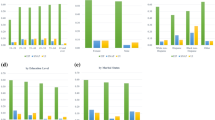Abstract
Many studies have identified that eligible claimants do not participate in means-tested income support programs. We examine the determinants of the decision to take-up social assistance in Canada using the 1997 Canadian Out of Employment Panel dataset. Using a conditional maximum likelihood approach to take account of the potential endogeneity of the level of benefits available to potential claimants, we find that benefit levels and recent receipt of Social Assistance (SA) are important determinants of the take-up decision. The results are important for the fiscal implications of changing benefit levels as the take-up rate is systematically related to the benefits potential recipients are entitled to receive. Further, it suggests that stigma and transaction costs associated with program use are important in explaining the take-up decision.
Similar content being viewed by others
References
Allen DW (1993) Welfare and the family: the Canadian experience. J Labor Econ 11: 201–223
Andrade C (2002) The economics of welfare participation and welfare stigma: a review. Public Finan Manage 2: 294–333
Barrett GF, Cragg MI (1998) An untold story: the characteristics of welfare use in British Columbia. Can J Econ 31: 165–188
Barrett G, Doiron D, Green D, Riddell C (1996) The interaction of unemployment insurance and social assistance. Human Resources Development Corporation, Evaluation Brief #18, Ottawa
Bitler MP, Currie J, Scholz J (2003) WIC eligibility and participation. J Hum Resour 38: 1039–1079
Blank R, Card D (1991) Recent trends in insured and uninsured unemployment: is there an explanation?. Q J Econ 106: 1157–1189
Blank R, Ruggles P (1996) When do women use aid to families with dependent children and food stamps? The dynamics of eligibility versus participation. J Hum Resour 31: 57–89
Blundell R, Fry V, Walker I (1988) Modeling the take-up of means tested benefits: the case of housing benefits in the United Kingdom. Econ J 98: 58–74
Browning M, Jones R, Kuhn P (1995) Studies of the interaction of UI and welfare using the COEP dataset. Human Resources Development Canada, Evaluation Brief #3, Ottawa
Bruce R, Bailey N, Warburton WP, Cragg JG, Nakamura A (1996) Those returning to income assistance. Can J Econ 29: S33–S38
Charette MF, Meng R (1994) The determinants of welfare participation for female heads of household in Canada. Can J Econ 27: 290–306
Christofides LN (2000) Social assistance and labour supply. Can J Econ 33: 715–741
Christofides LN, Stengos T, Swidinsky R (1997) Welfare participation and labour market behaviour in Canada. Can J Econ 30: 595–621
Clark C (1998) Canada’s income security programs. Canadian Council on Social Development, Ottawa
Currie J (2004) The take- up of social benefits. NBER working paper, 10488
Dooley MD (1999) The evolution of welfare participation among Canadian lone mothers, 1973–1991. Can J Econ 32: 589–612
Dorsett R, Heady C (1991) The take-up of means-tested benefits by working families with children. Fiscal Stud 12: 22–32
Employment Insurance Act (1996)
Evans WN, Oates WE, Schwab RM (1992) Measuring peer group effects: a study of teenage behaviour. J Political Econ 100: 966–992
Greene WH (1993) Econometric analysis. Macmillan, New York
Grey A (2002) Employment insurance and social assistance: evidence on program interaction, Final Report: Human Resources Development Canada, January
Haider SJ, Jacknowitz A, Schoeni RF (2003) Food stamps and the elderly—why is participation so low?. J Hum Resour 38: 1080–1111
Hernanz V, Malherbet F, Pellizzari M (2004) Take-up of welfare benefits in OECD countries: a review of the evidence. OECD Social, Employment and Immigration Working Papers no. 17
Hoynes H (1996) Welfare transfers in two-parent families: labor supply and welfare participation under AFDC-UP. Econometrica 64: 295–332
Human Resources Development Canada (HRDC) (2001) Did the social assistance take-up rate change after EI reform for job separators? Human Resources Development Canada (HRDC), Ottawa
Kayser H, Frick JR (2001) Take it or leave it: (non-)take-up behavior of social assistance in Germany. J Appl Soc Sci Stud 121: 27–58
McGarry K (1996) Factors determining participation of the elderly in supplemental security income. J Hum Resour 31: 331–358
Moffitt R (1983) An economic model of welfare stigma. Am Econ Rev 73: 1023–1035
National Council of Welfare (1996) Welfare incomes 1995. Minister of Public Works and Government Services, Ottawa
National Council of Welfare (1997a) Another look at welfare reform. Minister of Public Works and Government Services, Ottawa
National Council of Welfare (1997) Welfare incomes 1996. Minister of Public Works and Government Services, Ottawa
National Council of Welfare (1999) Welfare incomes 1997 and 1998. Minister of Public Works and Government Services, Ottawa
National Council of Welfare (2000a) Welfare incomes 1997 and 1998, a report by the National Council of Welfare. Minister of Public Works and Government Services, Ottawa
National Council of Welfare (2000b) Welfare incomes 1999. Minister of Public Works and Government Services, Ottawa
Pudney S, Hernandez M, Hancock R (2002) The welfare cost of means-testing: pensioner participation in income support. Discussion Papers in Economics 03/2: Department of Economics, University of Leicester
Riphahn R (2001) Rational poverty or poor rationality? The take-up of social assistance benefits. Rev Income Wealth 47: 379–398
Sargent T (1998) The BU ratio: prospect and retrospect, Working Paper 98–09: Department of Finance, October, Ottawa
Social Development Canada (1994) Social Assistance in Canada-1994. http://www.sdc.gc.ca/en/cs/sp/socpol/publications/reports/1996-000047/page09.shtml. accessed on 23 June, 2005
Storer P, Van Audenrode MA (1995) Unemployment insurance take-up rates in Canada: facts, determinants and implications. Can J Econ 28: 822–835
United States Department for Health and Human Services (2005) Indicators of Welfare Dependence. Annual Report to Congress
Wooldridge JM (2002) Econometric analysis of cross section and panel data. MIT Press, MA, Cambridge
Author information
Authors and Affiliations
Corresponding author
Rights and permissions
About this article
Cite this article
Whelan, S. The take-up of means-tested income support. Empir Econ 39, 847–875 (2010). https://doi.org/10.1007/s00181-009-0329-z
Received:
Accepted:
Published:
Issue Date:
DOI: https://doi.org/10.1007/s00181-009-0329-z




